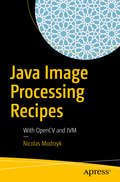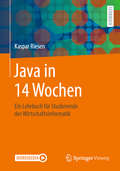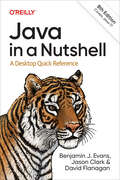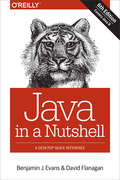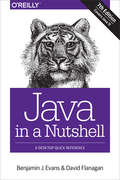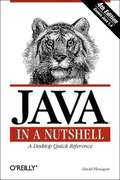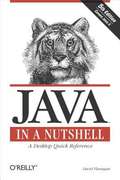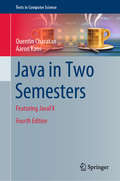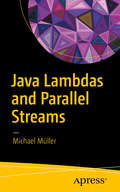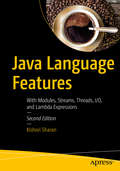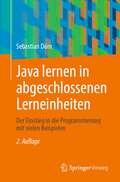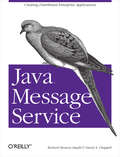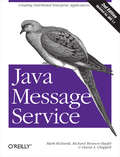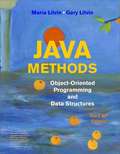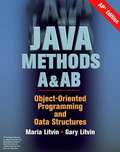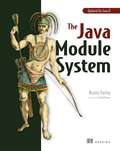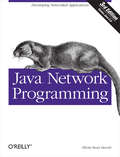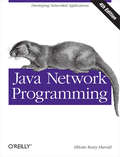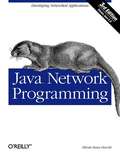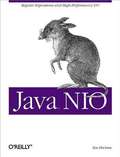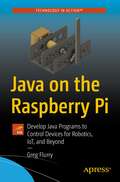- Table View
- List View
Java Image Processing Recipes: With OpenCV and JVM
by Nicolas ModrzykQuickly obtain solutions to common Java image processing problems, learn best practices, and understand everything OpenCV has to offer for image processing. You will work with a JVM image wrapper to make it very easy to run image transformation through pipelines and obtain instant visual feedback. This book makes heavy use of the Gorilla environment where code can be executed directly in the browser, and image transformation results can also be visualized directly in the browser.Java Image Processing Recipes includes recipes on more advanced image manipulation techniques, such as image smoothing, cartooning, sketching, and mastering masks to apply changes only to parts of the image. You’ll see how OpenCV features provide instant solutions to problems such as edges detection and shape finding. Finally, the book contains practical recipes dealing with webcams and various video streams, giving you ready-made code with which to do real-time video analysis. What You Will LearnCreate your personal real-time image manipulation environmentManipulate image characteristics with OpenCVWork with the Origami image wrapperApply manipulations to webcams and video streamsWho This Book Is ForDevelopers that want to manipulate images and use other advanced imaging techniques, through code running in the JVM.
Java in 14 Wochen: Ein Lehrbuch für Studierende der Wirtschaftsinformatik
by Kaspar RiesenDieses Buch ist der ideale Begleiter, wenn Sie in einem Semester Java lernen möchten. Der Inhalt wurde gezielt ausgewählt, so dass nur die Konzepte besprochen werden, die Sie zum Einstieg in die Programmierung wirklich benötigen. Diese Konzepte werden mit zahlreichen, anschaulichen Beispielen illustriert. Weiter wird im Buch ein durchgehendes Beispielprojekt in Java, das von Kapitel zu Kapitel wächst, entwickelt. Zu jedem Kapitel finden sich zudem viele Aufgaben zur Selbstkontrolle und Programmierübungen in Java. Zu jeder Übung ist ein Lernvideo verlinkt, auf dem der Autor des Buches die Übung vorprogrammiert. Das Buch ist somit optimal geeignet für Studierende der Wirtschaftsinformatik, Informatik oder anderer Fachrichtungen sowie für alle Interessierten, die ohne Vorkenntnisse Programmieren lernen möchten.
Java in a Nutshell
by Benjamin J Evans Jason Clark David FlanaganThis updated edition of the Nutshell guide not only helps experienced Java programmers get the most out of versions through Java 17, it also serves as a learning path for new developers. Chock-full of examples that demonstrate how to take complete advantage of modern Java APIs and development best practices, this thoroughly revised book includes new material on recent enhancements to the Java object model that every developer should know about.The first section provides a fast-paced, no-fluff introduction to the Java programming language and the core runtime aspects of the Java platform. The second section is a reference to core concepts and APIs that explains how to perform real programming work in the Java environment.Get up to speed on language details through Java 17Learn object-oriented programming using basic Java syntaxExplore generics, enumerations, annotations, and lambda expressionsUnderstand techniques used in object-oriented designExamine how concurrency and memory are intertwinedWork with Java collections and handle common data formatsDelve into Java's latest I/O APIs including asynchronous channelsBecome familiar with development tools in OpenJDK
Java in a Nutshell
by Benjamin J Evans David FlanaganThe latest edition of Java in a Nutshell is designed to help experienced Java programmers get the most out of Java 7 and 8, but it's also a learning path for new developers. Chock full of examples that demonstrate how to take complete advantage of modern Java APIs and development best practices, the first section of this thoroughly updated book provides a fast-paced, no-fluff introduction to the Java programming language and the core runtime aspects of the Java platform.The second section is a reference to core concepts and APIs that shows you how to perform real programming work in the Java environment.Get up to speed on language details, including Java 8 changesLearn object-oriented programming, using basic Java syntaxExplore generics, enumerations, annotations, and lambda expressionsUnderstand basic techniques used in object-oriented designExamine concurrency and memory, and how they're intertwinedWork with Java collections and handle common data formatsDelve into Java's latest I/O APIs, including asynchronous channelsUse Nashorn to execute JavaScript on the Java Virtual MachineBecome familiar with development tools in OpenJDK
Java in a Nutshell: A Desktop Quick Reference (Seventh Edition) (In a Nutshell)
by David Flanagan Ben Evans<p>This updated edition of Java in a Nutshell not only helps experienced Java programmers get the most out of Java versions 9 through 11, it’s also a learning path for new developers. Chock full of examples that demonstrate how to take complete advantage of modern Java APIs and development best practices, this thoroughly revised book includes new material on Java Concurrency Utilities. <p>The book’s first section provides a fast-paced, no-fluff introduction to the Java programming language and the core runtime aspects of the Java platform. The second section is a reference to core concepts and APIs that explains how to perform real programming work in the Java environment. <p>Get up to speed on language details, including Java 9-11 changes; Learn object-oriented programming, using basic Java syntax; Explore generics, enumerations, annotations, and lambda expressions; Understand basic techniques used in object-oriented design; Examine concurrency and memory, and how they’re intertwined; Work with Java collections and handle common data formats; Delve into Java’s latest I/O APIs, including asynchronous channels; Use Nashorn to execute JavaScript on the Java Virtual Machine; Become familiar with development tools in OpenJDK.</p>
Java In a Nutshell, 4th Edition
by David FlanaganJava just keeps growing, adding features, functionality, complexity, and tempting developers to growl with frustration. The new 1.4 release of Java 2 Standard edition increases the size of the platform by 50%, to 2757 classes in 135 packages. How are you going to figure out what this means for your applications? As always, Java in a Nutshell has the answers. The new 4th edition still contains an accelerated introduction to the Java programming language and its key APIs so you can start writing code right away. And with more than 250 new pages, author David Flanagan quickly brings you up to speed on new features that come with version 1.4: High-performance NIO API Support for pattern matching with regular expressions A logging API A user preferences API New Collections classes An XML-based persistence mechanism for Java Beans Support for XML parsing using both the DOM and SAX APIs User authentication with the JAAS API Support for secure network connections using the SSL protocol Support for cryptography The book contains O'Reilly's classic quick-reference for all the classes in the essential Java packages, so you can dive in and find what you need to make the new 1.4 version work for you. For as long as Java developers have existed, Java in a Nutshell has been ready, willing and able to take you right to the heart of the program, turning those frustrated grrrrss into purrrss of satisfaction. No wonder readers of Java Developer's Journal voted this the "Best Java Book" the past two years in a row!
Java in a Nutshell, 5th Edition
by David FlanaganThe 1.4 release of Java 2 Standard edition brings a load of new features - and the potential for frustration. Fret not, our new 4th edition has answers. The accelerated introduction lets you start writing code right away, and because the book's classic quick reference contains all the classes in the essential Java packages, you can find exactly what you need to make Java's new version work for you.
Java in Two Semesters: Featuring JavaFX (Texts in Computer Science )
by Quentin Charatan Aaron KansThis easy-to-follow textbook teaches Java programming from first principles, as well as covering design and testing methodologies. The text is divided into two parts. Each part supports a one-semester module, the first part addressing fundamental programming concepts, and the second part building on this foundation, teaching the skills required to develop more advanced applications. <P><P> This fully updated and greatly enhanced fourth edition covers the key developments introduced in Java 8, including material on JavaFX, lambda expressions and the Stream API. <P><P> Topics and features: begins by introducing fundamental programming concepts such as declaration of variables, control structures, methods and arrays; goes on to cover the fundamental object-oriented concepts of classes and objects, inheritance and polymorphism; uses JavaFX throughout for constructing event-driven graphical interfaces; includes advanced topics such as interfaces and lambda expressions, generics, collection classes and exceptions; explains file-handling techniques, packages, multi-threaded programs, socket programming, remote database access and processing collections using streams; includes self-test questions and programming exercises at the end of each chapter, as well as two illuminating case studies; provides additional resources at its associated website (simply go to springer.com and search for "Java in Two Semesters"), including a guide on how to install and use the NetBeans™ Java IDE. Offering a gentle introduction to the field, assuming no prior knowledge of the subject, Java in Two Semesters is the ideal companion to undergraduate modules in software development or programming.
Java Lambdas and Parallel Streams
by Michael MüllerThis compact book introduces the concepts of Java lambdas and parallel streams in a concise form. It begins by introducing new supporting features such as functional interfaces, default methods and more. After this, the author demonstrates how streams can be parallelized in a very simple way—within certain limits, no knowledge about the thread management is needed. Nevertheless, some basic elements in the context of parallelism need to be considered. Here, the book provides a variety of information and best practices.What You Will LearnMaster lambdas and streamsWork with the default methodHarness streams and the stream() function Use Stream and SpliteratorTake advantage of parallel streamsWork with collectors and concurrencyWho This Book Is ForExperienced Java programmers and developers.div>
Java Language Features: Lambda Expressions, Inner Classes, Threads, I/o And Collections
by Kishori SharanWork with essential and advanced features of the Java programming language such as Java modules development, lambda expressions (closures), inner classes, threads, I/O, Collections, garbage collection, and more. Author Kishori Sharan provides over 50 diagrams and 290 complete programs to help you visualize and better understand the topics covered in this book.Java Language Features, Second Edition starts with a series of chapters on the essential language features provided by Java, including annotations, reflection, and generics. These topics are then complemented by details of how to use lambda expressions, allowing you to build powerful and efficient Java programs. The chapter on threads follows this up and discusses everything from the very basic concepts of a thread to the most advanced topics such as synchronizers, the fork/join framework, and atomic variables.This book contains unmatched coverage of Java NIO, the Stream API, the Path API, the FileVisitor API, the watch service, and asynchronous file I/O. With this in-depth knowledge, your data- and file-management programs will be able to take advantage of every feature of Java's powerful I/O framework and much more.Additionally, three appendices are available for free via the Download Source Code on apress.com. These appendices will give you a head start on the most important features of Java 10 and the new Java versioning scheme.What You’ll LearnUse essential and advanced features of the Java languageCode Java annotations and inner classesWork with reflection, generics, and threadsTake advantage of the garbage collectorManage streams with the Stream APIWho This Book Is ForThose new to Java programming and continues the learning Java journey; it is recommended that you read an introductory Java programming book first, such as Beginning Java Fundamentals, from Apress.
Java lernen in abgeschlossenen Lerneinheiten: Der Einstieg in die Programmierung mit vielen Beispielen
by Sebastian DörnDieses Lehrbuch bringt Einsteiger anhand einzelner abgeschlossener Lerneinheiten das Programmieren mit Java bei. Es zeigt den Entwurf von effizienten Daten- und Ablaufstrukturen und versetzt die Leser dadurch in die Lage, algorithmische Konzepte zu verstehen und in Programmcode umzusetzen.Zentrale Lernziele sind das Verstehen der Abstraktionskonzepte moderner Programmiersprachen und das Erlernen des logischen und algorithmischen Denkens: Das Buch behandelt die strukturelle Programmierung, die Funktionsweise von Algorithmen, die Grundprinzipien der Objektorientierung und das Verarbeiten von Dateien. Die erweiterte neue Auflage umfasst auch die Bereiche Modultests, Vererbung, abstrakte Klassen, Interfaces und objektorientierte Entwurfsmuster.Zahlreiche Programmierbeispiele machen die einzelnen Konzepte begreifbar und leicht nachvollziehbar.Das Lehrbuch richtet sich an Studierende, Schüler, Lehrkräfte und an alle, die einen schnellen Einstieg in die Programmierung mit Java suchen.
Java Memory Management: A comprehensive guide to garbage collection and JVM tuning
by Sean Kennedy Maaike van PuttenImprove application performance by tuning, monitoring and profiling both the garbage collector and JVMKey FeaturesUnderstand the different parts of Java memory and the various garbage collectors so you can select your preferred oneExplore how memory management can help to effectively improve performanceLearn how to spot and avoid memory leaks to enhance application performanceBook DescriptionUnderstanding how Java organizes memory is important for every Java professional, but this particular topic is a common knowledge gap for many software professionals. Having in-depth knowledge of memory functioning and management is incredibly useful in writing and analyzing code, as well as debugging memory problems. In fact, it can be just the knowledge you need to level up your skills and career.In this book, you'll start by working through the basics of Java memory. After that, you'll dive into the different segments individually. You'll explore the stack, the heap, and the Metaspace. Next, you'll be ready to delve into JVM standard garbage collectors. The book will also show you how to tune, monitor and profile JVM memory management. Later chapters will guide you on how to avoid and spot memory leaks.By the end of this book, you'll have understood how Java manages memory and how to customize it for the benefit of your applications.What you will learnUnderstand the schematics of debugging and how to design the application to perform wellDiscover how garbage collectors workDistinguish between various garbage collector implementationsIdentify the metrics required for analyzing application performanceConfigure and monitor JVM memory managementIdentify and solve memory leaksWho this book is forThis book is for all levels of Java professionals, regardless of whether you're a junior or senior developer, a DevOps engineer, a tester, or the system admin of a Java application. If you currently don't have in-depth knowledge of Java memory, garbage collection, and/or JVM tuning, then this book will help you to take your Java skills to the next level.
Java Message Service
by Dave Chappell Richard Monson-HaefelThis book is a thorough introduction to Java Message Service (JMS) from Sun Microsystems. It shows how to build applications using the point-to-point and publish-and-subscribe models; use features like transactions and durable subscriptions to make applications reliable; and use messaging within Enterprise JavaBeans. It also introduces a new EJB type, the MessageDrivenBean, that is part of EJB 2.0, and discusses integration of messaging into J2EE.
Java Message Service
by David A Chappell Richard Monson-HaefelThis book is a thorough introduction to Java Message Service (JMS), the standard Java application program interface (API) from Sun Microsystems that supports the formal communication known as "messaging" between computers in a network. JMS provides a common interface to standard messaging protocols and to special messaging services in support of Java programs. The messages exchange crucial data between computers, rather than between users--information such as event notification and service requests. Messaging is often used to coordinate programs in dissimilar systems or written in different programming languages. Using the JMS interface, a programmer can invoke the messaging services of IBM's MQSeries, Progress Software's SonicMQ, and other popular messaging product vendors. In addition, JMS supports messages that contain serialized Java objects and messages that contain Extensible Markup Language (XML) pages. Messaging is a powerful new paradigm that makes it easier to uncouple different parts of an enterprise application. Messaging clients work by sending messages to a message server, which is responsible for delivering the messages to their destination. Message delivery is asynchronous, meaning that the client can continue working without waiting for the message to be delivered. The contents of the message can be anything from a simple text string to a serialized Java object or an XML document. Java Message Service shows how to build applications using the point-to-point and publish-and-subscribe models; how to use features like transactions and durable subscriptions to make an application reliable; and how to use messaging within Enterprise JavaBeans. It also introduces a new EJB type, the MessageDrivenBean, that is part of EJB 2.0, and discusses integration of messaging into J2EE.
Java Message Service: Creating Distributed Enterprise Applications
by Richard Monson-Haefel David A Chappell Mark RichardsJava Message Service, Second Edition, is a thorough introduction to the standard API that supports "messaging" -- the software-to-software exchange of crucial data among network computers. You'll learn how JMS can help you solve many architectural challenges, such as integrating dissimilar systems and applications, increasing scalability, eliminating system bottlenecks, supporting concurrent processing, and promoting flexibility and agility. Updated for JMS 1.1, this second edition also explains how this vendor-agnostic specification will help you write messaging-based applications using IBM's MQ, Progress Software's SonicMQ, ActiveMQ, and many other proprietary messaging services. With Java Message Service, you will: Build applications using point-to-point and publish-and-subscribe messaging models Use features such as transactions and durable subscriptions to make an application reliable Implement messaging within Enterprise JavaBeans (EJB) using message-driven beans Use JMS with RESTful applications and with the Spring application framework Messaging is a powerful paradigm that makes it easier to uncouple different parts of an enterprise application. Java Message Service, Second Edition, will quickly teach you how to use the key technology that lies behind it.
Java Methods: Object-Oriented Programming and Data Structures
by Maria Litvin Gary LitvinThis book offers a thorough introduction to the concepts and practices of object-oriented programming in Java. It also introduces the most common data structures and related algorithms and their implementations in the Java collections framework. Chapters 1 14 follow the syllabus of the AP Computer Science in Java course. They will prepare you well for the AP CS exam. Chapters 15-18 on file input and output, graphics, graphical user interfaces, and events handling in Java will give you a better sense of real-world Java programming; this material also makes case studies, labs, and exercises more fun. Chapters 19-26 deal with more advanced data structures and algorithms. Chapter 27, Design Patterns, introduces more intricate aspects of object-oriented design and serves as an introduction to design patterns. The last chapter, Computing in Context, discusses creative, responsible, and ethical computer use.
Java Methods A & AB: Object-Oriented Programming and Data Structures, AP Edition
by Maria Litvin Gary LitvinIn one volume, this edition covers both introductory Java/OOP A-level material and AB-level topics (data structures and algorithms). The book follows Java 5.0 and incorporates many other changes, big and small, to reflect the current priorities of the AP CS program. This edition offers an early focus on object-oriented programming and design and an expanded discussion of the Java collections framework.
The Java Module System
by Nicolai ParlogSummaryJava's much-awaited "Project Jigsaw" is finally here! Java 11 includes a built-in modularity framework, and The Java Module System is your guide to discovering it. In this new book, you'll learn how the module system improves reliability and maintainability, and how it can be used to reduce tight coupling of system components.Foreword by Kevlin Henney.Purchase of the print book includes a free eBook in PDF, Kindle, and ePub formats from Manning Publications. You'll find registration instructions inside the print book.About the TechnologyPackaging code into neat, well-defined units makes it easier to deliver safe and reliable applications. The Java Platform Module System is a language standard for creating these units. With modules, you can closely control how JARs interact and easily identify any missing dependencies at startup. This shift in design is so fundamental that starting with Java 9, all core Java APIs are distributed as modules, and libraries, frameworks, and applications will benefit from doing the same.About the BookThe Java Module System is your in-depth guide to creating and using Java modules. With detailed examples and easy-to-understand diagrams, you'll learn the anatomy of a modular Java application. Along the way, you'll master best practices for designing with modules, debugging your modular app, and deploying to production.What's insideThe anatomy of a modular Java appBuilding modules from source to JARMigrating to modular JavaDecoupling dependencies and refining APIsHandling reflection and versioningCustomizing runtime imagesUpdated for Java 11About the ReaderPerfect for developers with some Java experience.About the AuthorNicolai Parlog is a developer, author, speaker, and trainer. His home is codefx.org. Table of ContentsPART 1 - Hello, modulesFirst piece of the puzzleAnatomy of a modular applicationDefining modules and their propertiesBuilding modules from source to JARRunning and debugging modular applicationsPART 2 - Adapting real-world projectsCompatibility challenges when moving to Java 9 or laterRecurring challenges when running on Java 9 or laterIncremental modularization of existing projectsMigration and modularization strategiesPART 3 - Advanced module system featuresUsing services to decouple modulesRefining dependencies and APIsReflection in a modular worldModule versions: What's possible and what's notCustomizing runtime images with jlinkPutting the pieces together
Java Network Programming
by Elliotte Rusty HaroldThe new third edition of this highly regarded introduction to Java networking programming has been thoroughly revised to cover all of the 100+ significant updates to Java Developers Kit (JDK) 1.5. It is a clear, complete introduction to developing network programs (both applets and applications) using Java, covering everything from networking fundamentals to remote method invocation (RMI).Java Network Programming, 3rd Edition includes chapters on TCP and UDP sockets, multicasting protocol and content handlers, servlets, multithreaded network programming, I/O, HTML parsing and display, the Java Mail API, and the Java Secure Sockets Extension. There's also significant information on the New I/O API that was developed in large part because of the needs of network programmers.This invaluable book is a complete, single source guide to writing sophisticated network applications. Packed with useful examples, it is the essential resource for any serious Java developer.
Java Network Programming: Developing Networked Applications (Java Ser.)
by Elliotte Rusty HaroldThe new third edition of this highly regarded introduction to Java networking programming has been thoroughly revised to cover all of the 100+ significant updates to Java Developers Kit (JDK) 1.5. It is a clear, complete introduction to developing network programs (both applets and applications) using Java, covering everything from networking fundamentals to remote method invocation (RMI). Java Network Programming, 3rd Edition includes chapters on TCP and UDP sockets, multicasting protocol and content handlers, servlets, multithreaded network programming, I/O, HTML parsing and display, the Java Mail API, and the Java Secure Sockets Extension. There's also significant information on the New I/O API that was developed in large part because of the needs of network programmers. This invaluable book is a complete, single source guide to writing sophisticated network applications. Packed with useful examples, it is the essential resource for any serious Java developer.
Java Network Programming, 2nd Edition
by Elliotte Rusty HaroldThis complete guide to developing network programs (both applets and applications) using Java covers everything from networking fundamentals to remote method invocation (RMI). It includes chapters on TCP and UDP sockets, multicasting protocol and content handlers, and servlets. This second edition also covers Java 1.1, 1.2 and 1.3, with new chapters on multithreaded network programming, I/O, HTML parsing and display, the Java Mail API, the Java Secure Sockets Extension, and more.
Java Network Programming, 3rd Edition
by Elliotte HaroldThe new third edition of this highly regarded introduction to Java networking programming has been thoroughly revised to cover all of the 100+ significant updates to Java Developers Kit (JDK) 1.5. It is a clear, complete introduction to developing network programs (both applets and applications) using Java, covering everything from networking fundamentals to remote method invocation (RMI). Java Network Programming, 3rd Edition includes chapters on TCP and UDP sockets, multicasting protocol and content handlers, servlets, multithreaded network programming, I/O, HTML parsing and display, the Java Mail API, and the Java Secure Sockets Extension. There's also significant information on the New I/O API that was developed in large part because of the needs of network programmers. This invaluable book is a complete, single source guide to writing sophisticated network applications. Packed with useful examples, it is the essential resource for any serious Java developer.
Java Network Programming, 3rd Edition
by Elliotte Rusty HaroldThe new third edition of this highly regarded introduction to Java networking programming has been thoroughly revised to cover all of the 100+ significant updates to Java Developers Kit (JDK) 1.5. It is a clear, complete introduction to developing network programs (both applets and applications) using Java, covering everything from networking fundamentals to remote method invocation (RMI). Java Network Programming , 3rd Edition includes chapters on TCP and UDP sockets, multicasting protocol and content handlers, servlets, multithreaded network programming, I/O, HTML parsing and display, the Java Mail API, and the Java Secure Sockets Extension. There's also significant information on the New I/O API that was developed in large part because of the needs of network programmers. This invaluable book is a complete, single source guide to writing sophisticated network applications. Packed with useful examples, it is the essential resource for any serious Java developer.
Java NIO
by Ron HitchensMany serious Java programmers, especially enterprise Java programmers, consider the new I/O API--called NIO for New Input/Output--the most important feature in the 1.4 version of the Java 2 Standard Edition. The NIO package includes many things that have been missing from previous editions of Java that are critical to writing high-performance, large-scale applications: improvements in the areas of buffer management, scalable network and file I/O, character-set support, and regular expression matching. Most of all, it boosts performance and speed dramatically. Java NIO explores the new I/O capabilities of version 1.4 in detail and shows you how to put these features to work to greatly improve the efficiency of the Java code you write. This compact volume examines the typical challenges that Java programmers face with I/O and shows you how to take advantage of the capabilities of the new I/O features. You?ll learn how to put these tools to work using examples of common, real-world I/O problems and see how the new features have a direct impact on responsiveness, scalability, and reliability. The book includes: A rundown of the new features in NIO Basic and advanced I/O Concepts Binary I/O and the new buffer classes Memory mapped files and file locking Character I/O: encoding, decoding and transforming character data Regular Expressions and the new java.util.regex package Muliplexing with java.nio Because the NIO APIs supplement the I/O features of version 1.3, rather than replace them, you'll also learn when to use new APIs and when the older 1.3 I/O APIs are better suited to your particular application. Java NIO is for any Java programmer who is interested in learning how to boost I/O performance, but if you're developing applications where performance is critical, such as game computing or large-scale enterprise applications, you'll want to give this book a permanent spot on your bookshelf. With the NIO APIs, Java no longer takes a backseat to any language when it comes to performance. Java NIO will help you realize the benefits of these exciting new features.
Java on the Raspberry Pi: Develop Java Programs to Control Devices for Robotics, IoT, and Beyond
by Greg FlurryUse Java to do whatever you want to do with the Raspberry Pi and the devices you need for your project. In theory, it should be possible, and even easy, to work with on the Pi. Unfortunately, reality is a bit different. This book features an extensive set of techniques that allow you to get close to bringing this theory to fruition.You'll review some limitations on using Java imposed by the Raspberry Pi and Raspberry Pi OS, and even Java itself, and examine which ones might apply to your projects and your devices. You'll also explore solutions to address the limitations and l look at efficient development of Java for the Raspberry Pi. Java on the Raspberry Pi shows how to interact with a range of devices useful in robotics and IOT, overcoming the hurdles in doing so. It also covers off-loading work from the Raspberry Pi to an Arduino, leveraging its close-to-real time capabilities. What You'll Learn Develop with Java remotely using NetBeans Leverage available libraries to enable device interaction, and what to do if they don’t work Implement multi-processing, using an Arduino as a co-processorBuild sophisticated projects with multiple threads of execution, multiple processes, and even multiple systems Who This Book Is ForExperienced programmers who appreciate the benefits of Java and world class tools for application development and want to build robotics or IOT projects using the low cost, low power, and portability of the Raspberry Pi.
